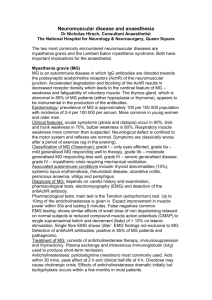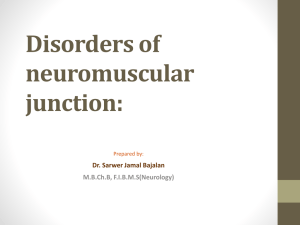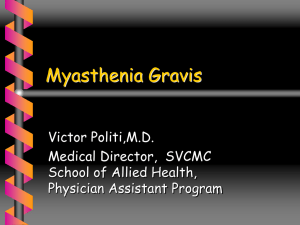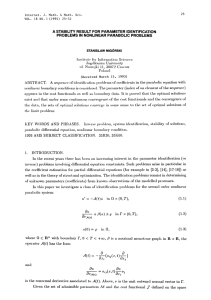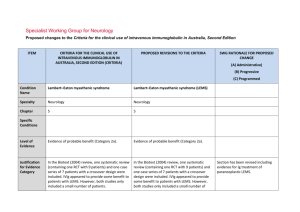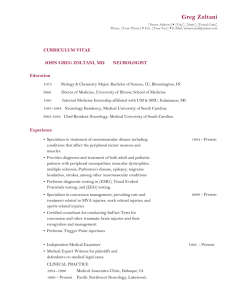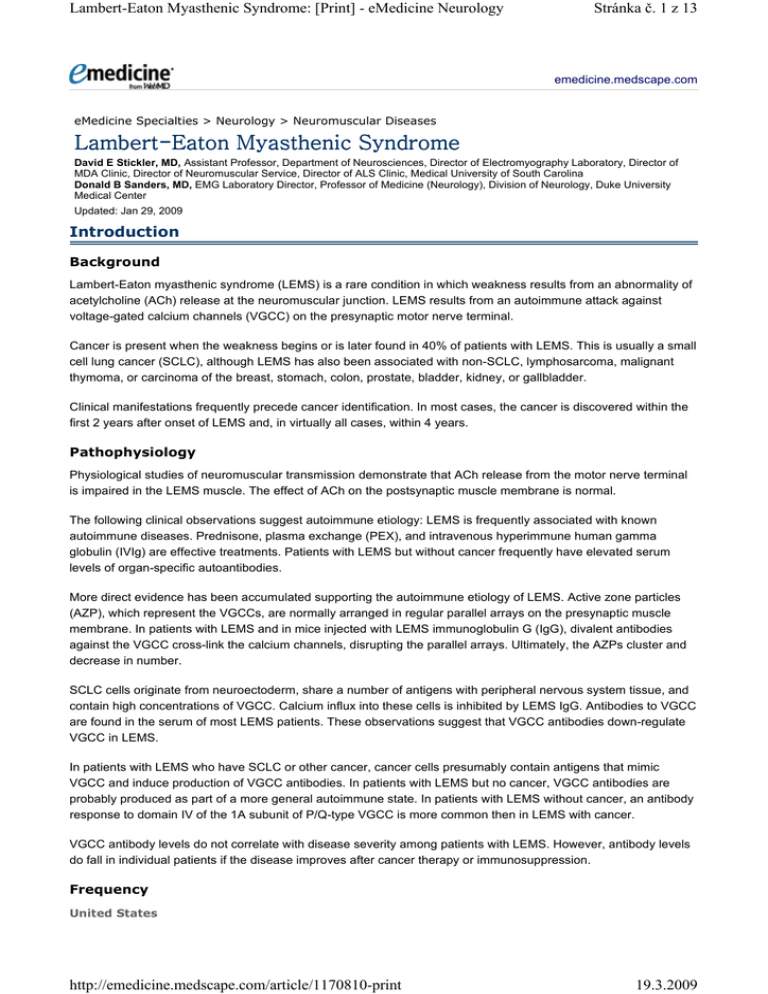
Lambert-Eaton Myasthenic Syndrome: [Print] - eMedicine Neurology
Stránka č. 1 z 13
emedicine.medscape.com
eMedicine Specialties > Neurology > Neuromuscular Diseases
LambertLambert-Eaton Myasthenic Syndrome
David E Stickler, MD, Assistant Professor, Department of Neurosciences, Director of Electromyography Laboratory, Director of
MDA Clinic, Director of Neuromuscular Service, Director of ALS Clinic, Medical University of South Carolina
Donald B Sanders, MD, EMG Laboratory Director, Professor of Medicine (Neurology), Division of Neurology, Duke University
Medical Center
Updated: Jan 29, 2009
Introduction
Background
Lambert-Eaton myasthenic syndrome (LEMS) is a rare condition in which weakness results from an abnormality of
acetylcholine (ACh) release at the neuromuscular junction. LEMS results from an autoimmune attack against
voltage-gated calcium channels (VGCC) on the presynaptic motor nerve terminal.
Cancer is present when the weakness begins or is later found in 40% of patients with LEMS. This is usually a small
cell lung cancer (SCLC), although LEMS has also been associated with non-SCLC, lymphosarcoma, malignant
thymoma, or carcinoma of the breast, stomach, colon, prostate, bladder, kidney, or gallbladder.
Clinical manifestations frequently precede cancer identification. In most cases, the cancer is discovered within the
first 2 years after onset of LEMS and, in virtually all cases, within 4 years.
Pathophysiology
Physiological studies of neuromuscular transmission demonstrate that ACh release from the motor nerve terminal
is impaired in the LEMS muscle. The effect of ACh on the postsynaptic muscle membrane is normal.
The following clinical observations suggest autoimmune etiology: LEMS is frequently associated with known
autoimmune diseases. Prednisone, plasma exchange (PEX), and intravenous hyperimmune human gamma
globulin (IVIg) are effective treatments. Patients with LEMS but without cancer frequently have elevated serum
levels of organ-specific autoantibodies.
More direct evidence has been accumulated supporting the autoimmune etiology of LEMS. Active zone particles
(AZP), which represent the VGCCs, are normally arranged in regular parallel arrays on the presynaptic muscle
membrane. In patients with LEMS and in mice injected with LEMS immunoglobulin G (IgG), divalent antibodies
against the VGCC cross-link the calcium channels, disrupting the parallel arrays. Ultimately, the AZPs cluster and
decrease in number.
SCLC cells originate from neuroectoderm, share a number of antigens with peripheral nervous system tissue, and
contain high concentrations of VGCC. Calcium influx into these cells is inhibited by LEMS IgG. Antibodies to VGCC
are found in the serum of most LEMS patients. These observations suggest that VGCC antibodies down-regulate
VGCC in LEMS.
In patients with LEMS who have SCLC or other cancer, cancer cells presumably contain antigens that mimic
VGCC and induce production of VGCC antibodies. In patients with LEMS but no cancer, VGCC antibodies are
probably produced as part of a more general autoimmune state. In patients with LEMS without cancer, an antibody
response to domain IV of the 1A subunit of P/Q-type VGCC is more common then in LEMS with cancer.
VGCC antibody levels do not correlate with disease severity among patients with LEMS. However, antibody levels
do fall in individual patients if the disease improves after cancer therapy or immunosuppression.
Frequency
United States
http://emedicine.medscape.com/article/1170810-print
19.3.2009
Lambert-Eaton Myasthenic Syndrome: [Print] - eMedicine Neurology
Stránka č. 2 z 13
An estimated 3% of patients with SCLC have LEMS. The prevalence of SCLC is 5 cases per million population in
the United States. Only half of patients with LEMS have a tumor, so total prevalence is at least double this figure (1
case per 100,000 population). Because in many patients LEMS is undiagnosed, the true incidence is probably
higher.
Mortality/Morbidity
Morbidity and mortality correlate with the morbidity and mortality of the underlying SCLC.
Sex
In earlier reports, LEMS occurred in males more frequently than females by a ratio of almost 2:1. However, more
recent studies show that the sex incidence is almost equal.
Age
LEMS usually begins in later adulthood; it can occur in children, but rarely.
Clinical
History
Symptoms usually begin insidiously. Many patients have symptoms for months or years before the diagnosis is
made. Weakness is the major symptom, with proximal muscles more affected than distal muscles (especially in the
lower limbs).
The typical patient with LEMS presents with slowly progressive proximal leg weakness.
Weak muscles may ache and are occasionally tender.
Oropharyngeal and ocular muscles may be mildly affected.
Respiratory muscles are not usually affected, but cases with severe respiratory compromise have
been reported.
Most patients have a dry mouth, which frequently precedes other symptoms of LEMS. Many do not mention
this unless specifically questioned.
Many patients report an unpleasant metallic taste.
Some patients have other manifestations of autonomic dysfunction, including impotence in males
and postural hypotension.
LEMS may be discovered first when prolonged paralysis follows the use of neuromuscular blocking agents
during surgery.
Exacerbation of weakness has been described following administration of aminoglycoside or
fluoroquinolone antibiotics, magnesium, calcium channel blockers, and iodinated intravenous contrast
agents.
Relationship between cancer and LEMS
Smoking and age at onset are major risk factors for cancer in patients with LEMS.
Duration of symptoms is a factor.
If a tumor is not found within the first 2 years after symptom onset, cancer is unlikely. For example, a
patient younger than 50 years at onset who does not have a tumor discovered after 2 years of close
follow-up is unlikely to have an underlying cancer. On the other hand, a long-term smoker with LEMS
onset after age 50 years probably has underlying lung cancer.
Physical
http://emedicine.medscape.com/article/1170810-print
19.3.2009
Lambert-Eaton Myasthenic Syndrome: [Print] - eMedicine Neurology
Stránka č. 3 z 13
Weakness is usually mild compared to the patient's reports.
Strength is usually reduced in proximal muscles of the legs and arms, producing a waddling gait and
difficulty elevating the arms.
Some degree of eyelid ptosis or diplopia, usually mild, is found in 25% of patients. Occasionally, difficulty
chewing, dysphagia, or dysarthria is present.
Most patients have a dry mouth, eyes, or skin.
In some patients, strength may improve after exercise and then weaken as activity is sustained. This is
demonstrable in approximately half of all patients with LEMS.
Tendon reflexes are reduced or absent but can frequently be provoked or increased by activating the
appropriate muscles or by repeatedly tapping the tendon.
Sensory examination is normal unless a coincident peripheral neuropathy is present, which is not
uncommon in patients with underlying cancer.
Tensilon or pyridostigmine may improve strength, but this is rarely as dramatic as in myasthenia gravis
(MG).
Causes
All patients with LEMS who have associated SCLC have a history of long-term smoking. Only half of patients with
autoimmune LEMS are long-term smokers.
Differential Diagnoses
Acute Inflammatory Demyelinating Polyradiculoneuropathy
Chronic Inflammatory Demyelinating Polyradiculoneuropathy
Dermatomyositis/Polymyositis
Inclusion Body Myositis
Myasthenia Gravis
Spinal Muscular Atrophy
Other Problems to Be Considered
Cachexia
Paraneoplastic neuropathy
Workup
Laboratory Studies
Voltage-gated calcium channel antibodies
VGCC antibodies have been reported in 75-100% of patients with Lambert-Eaton myasthenic
syndrome (LEMS) who have SCLC and in 50-90% of patients with LEMS without underlying cancer.
They are also found in fewer than 5% of patients with MG, in up to 25% of patients with lung cancer
without LEMS, and in some patients who do not have LEMS but have high levels of circulating
immunoglobulins (eg, systemic lupus erythematosus, rheumatoid arthritis).
Sensitivity and specificity of the VGCC assay are affected by the source of antigen and the specific
laboratory measuring the antibody.
Reports suggest that SOX1, an immunogenic tumor antigen in small cell lung cancer, may play a
role in identifying LEMS patients with lung cancer.1
http://emedicine.medscape.com/article/1170810-print
19.3.2009
Lambert-Eaton Myasthenic Syndrome: [Print] - eMedicine Neurology
Stránka č. 4 z 13
Imaging Studies
CT scanning or MRI of chest
SCLC is the malignancy most frequently associated with LEMS.
In all adult patients with LEMS, imaging studies of the chest for cancer detection should be
performed. If imaging findings are negative in a patient with a substantial risk of having lung cancer,
bronchoscopy should be performed. If both imaging and bronchoscopy results are initially negative
and risk factors for lung cancer are present, positron emission tomography (PET) scanning should
be considered. If all imaging study results are negative in such patients, periodic reassessment
thereafter is indicated.
Other Tests
Acetylcholine receptor antibodies
ACh receptor (AChR) antibodies are most commonly associated with MG.
AChR antibodies are occasionally found in low titers in LEMS.
Procedures
Repetitive nerve stimulation studies
These studies confirm the LEMS diagnosis by demonstrating characteristic findings on
electrodiagnostic studies (see Media file 1). Compound muscle action potentials (CMAPs) recorded
with surface electrodes are usually small, often less than 10% of normal, and fall during 1- to 5-Hz
repetitive nerve stimulation (RNS).
During stimulation at 20-50 Hz, the CMAP increases in size (ie, facilitation) and characteristically
becomes at least twice the size of the initial response.
A similar increase in CMAP size is seen immediately after the patient voluntarily contracts the
muscle maximally for several seconds (see Media file 2).
In virtually all patients with LEMS, a decremental response to low-frequency nerve stimulation is
observed in the hand muscles. This finding is not specific to LEMS and can be seen in MG and other
neuromuscular diseases.
In LEMS, the CMAP amplitude is low in most muscles tested. This finding is also nonspecific and is
commonly observed in other neuromuscular diseases.
Facilitation greater than 100% is seen in some but not all muscles (or in all patients) with LEMS.
Facilitation greater than 50% in any muscle suggests LEMS. However, these findings might also be
observed in MG. If facilitation is greater than 100% in most muscles tested or greater than 400% in
any muscle, the patient almost certainly has LEMS. If facilitation is less than 50% in all muscles
tested, the patient still may have LEMS, especially if weakness has been present for only a short
time or the patient has been partially treated.
When LEMS is mild, the electromyography (EMG) findings may resemble those of MG, including
normal CMAP amplitudes, decremental response to RNS at low rates, and little facilitation. One
helpful feature is that in LEMS, the EMG findings are usually more severe than the clinical findings
would suggest. The opposite is frequently true in MG.
Needle electromyography: Conventional needle EMG in LEMS demonstrates markedly unstable motor unit
action potentials, which vary in shape during voluntary activation.
Single-fiber electromyography
The jitter and blocking measured by single-fiber EMG is increased markedly in LEMS, frequently out
http://emedicine.medscape.com/article/1170810-print
19.3.2009
Lambert-Eaton Myasthenic Syndrome: [Print] - eMedicine Neurology
Stránka č. 5 z 13
of proportion to the severity of weakness.
In many endplates, jitter and blocking decrease as the firing rate increases. This pattern is not seen
in all endplates or in all patients with LEMS.
Because jitter and blocking may also decrease at higher firing rates in some endplates of patients
with MG, this pattern does not confirm an LEMS diagnosis unless it is dramatic and seen in most
muscles.
Bronchoscopy: If risk of lung cancer is substantial and findings on imaging studies are normal, perform
bronchoscopy to detect SCLC. If these findings are also normal, consider PET scanning.
Treatment
Medical Care
Individually tailor therapy on the basis of severity of weakness, underlying disease(s), life expectancy, and
response to previous treatment.
When the Lambert-Eaton myasthenic syndrome (LEMS) diagnosis is confirmed, extensively search
for an underlying malignancy with radiography and CT scanning of the chest, bronchoscopy, and
possibly PET scanning.
Initial treatment should be aimed at the neoplasm because weakness frequently improves with
effective cancer therapy. No further LEMS treatment may be necessary in some patients.
If no tumor is found, periodically search again for occult malignancy. Frequency of these evaluations is
determined by the patient's risk of cancer.
Patients younger than 50 years without history of long-term smoking have a low risk of associated
malignancy, especially if evidence of coexisting autoimmune disease is present. Extensive
surveillance for cancer may not be necessary for such patients.
Patients older than 50 years with history of long-term smoking almost certainly have underlying small
cell lung cancer (SCLC).
In patients with cancer, LEMS is usually not the major therapeutic concern. The initial concern is the cancer.
Immunotherapy of LEMS without effective treatment of the underlying cancer usually produces little
or no improvement in strength. A theoretical concern is that the immunosuppression may reduce
immunologic suppression of tumor growth.
In patients with LEMS who do not have cancer, aggressive immunotherapy is justified more readily.
Consultations
Appropriate consultations include a neurologist and may include an oncologist and a physical medicine specialist.
Medication
The initial pharmacotherapy of LEMS is with agents that increase the transmission of ACh across the
neuromuscular junction, either by increasing the release of ACh or by decreasing the action of
acetylcholinesterase. Treatment of the associated cancer may also decrease the weakness and other symptoms.
If these treatments are not effective and the patient has relatively mild weakness, determine if aggressive
immunotherapy is justified. When such therapy is warranted, PEX or high-dose IVIg may be used initially to induce
rapid, albeit transitory, improvement. Immunosuppressants should be added for more sustained improvement,
although a theoretical concern exists that immunologic suppression of tumor growth may thereby be reduced in
paraneoplastic LEMS.
http://emedicine.medscape.com/article/1170810-print
19.3.2009
Lambert-Eaton Myasthenic Syndrome: [Print] - eMedicine Neurology
Stránka č. 6 z 13
Prednisone and azathioprine, the most frequently used immunosuppressants, can be used alone or in combination.
Cyclosporine may benefit patients with LEMS who are candidates for immunosuppression but cannot take or do
not respond well to azathioprine. Improvement may be seen within 1-2 mo after beginning cyclosporine, while the
maximum response is usually observed in 3-4 mo.
PEX produces improvement in many patients with LEMS. Improvement is temporary unless the patient is also
receiving immunosuppression. Response to PEX in patients with LEMS is often more gradual than in those with
MG. Maximal response may take several weeks. Repeated courses of PEX may be necessary to maintain
improvement. PEX may be performed 4-6 times over 7-10 d, as described in standard protocols. Potential
complications include autonomic instability, hypercalcemia, and bleeding due to depletion of clotting factors.
IVIg, given in a course of 2 g/kg over 2-5 d, also induces clinically significant temporary improvement in many
patients. The frequency of improvement in response to repeated courses of treatment has not been determined.
Neuromuscular agents
These agents produce symptomatic improvement in strength, autonomic symptoms, or both in some patients with
LEMS.
Pyridostigmine bromide (Mestinon)
Acetylcholinesterase inhibitors do not usually produce dramatic improvement in LEMS, but they may provide relief
from weakness or dry mouth in some patients. Pyridostigmine is the preferred agent and should be administered
for several days before assessing response.
Dosing
Adult
30 or 60 mg PO q4-6h
Pediatric
Not established
Interactions
Complements beneficial actions and adverse GI effects of 3,4-diaminopyridine; increases effects of depolarizing
neuromuscular blockers; increases toxicity of edrophonium
Contraindications
Documented hypersensitivity; GI or GU obstruction
Precautions
Pregnancy
A - Fetal risk not revealed in controlled studies in humans
Precautions
Individually determine dose for each patient; an excessively high dose may cause diarrhea, abdominal cramping,
or increased weakness; beneficial and adverse actions of these medications complement those of 3,4diaminopyridine
3,4-Diaminopyridine (DAP)
Aminopyridines improve neuromuscular transmission by facilitating release of ACh from the motor nerve terminal.
http://emedicine.medscape.com/article/1170810-print
19.3.2009
Lambert-Eaton Myasthenic Syndrome: [Print] - eMedicine Neurology
Stránka č. 7 z 13
They act by presynaptic potassium channel blockade, prolonging action potentials and extending activation of
VGCC. For >20 y, has been used to improve strength and autonomic function in patients with LEMS. Effect begins
about 20 min after a PO dose. Each dose lasts about 4 h, and maximum effect of a given dosage may not be
observed for 2-3 d. Patients with or without underlying cancer benefit from DAP. In the authors' experience, >80%
of patients with LEMS have significant clinical benefit; in over half of these, improvement is marked. Not approved
for clinical use in the United States, but available on a compassionate-use basis for individual patients. In most
patients, pyridostigmine enhances and prolongs duration of action, permitting lower doses.
Obtain application process information from
Jacobus Pharmaceutical Co., Inc.
Princeton, NJ
Fax # 609-799-1176
Dosing
Adult
Optimal dose varies considerably among patients, so tailor dose and dosing schedule for each patient as follows:
10 mg PO tid/qid initial dose; observe response for 2 wk, increase dose in 5-mg increments at 2-wk intervals until
maximum benefit obtained; not to exceed 80 mg/d; add pyridostigmine, 30 or 60 mg tid, and note effect on
maximum response and on duration of action of each DAP dose; reduce DAP dose in 5-mg decrements until
lowest effective dose determined
Optimal dose of DAP may change, so periodically reassess response to medication by slowly reducing dose to
redetermine minimum dose that produces maximum response; repeat this procedure at least q12mo
Pediatric
Interactions
In most patients, pyridostigmine enhances and prolongs the duration of action of DAP and permits lower doses;
DAP may increase adverse GI effects of pyridostigmine; if this occurs, reduce dose of pyridostigmine
Contraindications
Documented hypersensitivity; history of seizures; cardiac arrhythmia
Precautions
Pregnancy
C - Fetal risk revealed in studies in animals but not established or not studied in humans; may use if benefits
outweigh risk to fetus
Precautions
Adverse effects minimal, usually limited to brief perioral and digital paresthesias, if dose is >10 mg; GI hyperactivity
with cramps and diarrhea may occur when DAP is taken with pyridostigmine; minimize this effect by reducing
pyridostigmine dose; seizures may occur at doses >100 mg/d; asthma attacks have been induced in patients with
preexisting asthma; theoretically, DAP could cause cardiac arrhythmia, although no such effects have been
reported; no known organ toxicity even in patients with LEMS who have taken aminopyridines for >10 y; because
clinical experience with these agents is limited, periodically perform blood tests of liver, kidney, and hematologic
functions to detect adverse effects; liver function tests, BUN and creatinine, and CBC should be performed q3mo
for first year, then q6-12mo
Guanidine HCl
Increases ACh release and temporarily improves strength in many patients with LEMS.
Maximal effect may take 2-3 d.
Dosing
http://emedicine.medscape.com/article/1170810-print
19.3.2009
Lambert-Eaton Myasthenic Syndrome: [Print] - eMedicine Neurology
Stránka č. 8 z 13
Adult
5-10 mg/kg/d PO divided throughout waking hours as initial dose; may increase prn, but not more often than q3d;
not to exceed 30 mg/kg/d depending on clinical response; adverse effects may be severe at doses > 1 g/d
Pediatric
Interactions
Pyridostigmine enhances therapeutic response to guanidine and permits lower dose
Contraindications
Documented hypersensitivity
Precautions
Pregnancy
C - Fetal risk revealed in studies in animals but not established or not studied in humans; may use if benefits
outweigh risk to fetus
Precautions
Use guanidine with extreme caution because of frequent adverse effects, including bone marrow suppression,
renal tubular acidosis, chronic interstitial nephritis, cardiac arrhythmia, hepatic toxicity, pancreatic dysfunction,
peripheral paresthesias, ataxia, confusion, and mood alterations; perform frequent blood tests of hematologic,
hepatic, and renal functions
Blood products
Intravenous immunoglobulin can be an effective treatment for LEMS.
Intravenous immunoglobulin (IVIg)
Features that may be relevant to efficacy include neutralization of circulating antibodies through anti-idiotypic
antibodies; down-regulation of proinflammatory cytokines, including IFN-gamma; blockade of Fc receptors on
macrophages; suppression of inducer T and B cells and augmentation of suppressor T cells; and blockade of
complement cascade.
Dosing
Adult
2 g/kg IV over 2-5 d
Pediatric
Administer as in adults
Interactions
None reported
Contraindications
Documented hypersensitivity; IgA deficiency; anti-IgE/IgG antibodies
Precautions
Pregnancy
C - Fetal risk revealed in studies in animals but not established or not studied in humans; may use if benefits
outweigh risk to fetus
http://emedicine.medscape.com/article/1170810-print
19.3.2009
Lambert-Eaton Myasthenic Syndrome: [Print] - eMedicine Neurology
Stránka č. 9 z 13
Precautions
Consider checking serum IgA before IVIg and using IgA-depleted IVIg (G-Gard-SD), if indicated
May increase serum viscosity and thromboembolic events; adverse effects may include migraine attacks; 10%
increased risk of aseptic meningitis; increased risk of urticaria, pruritus, or petechiae 2-5 d after infusion (possibly
lasting up to 1 mo); increased risk of renal tubular necrosis in older patients and patients with diabetes mellitus,
volume depletion, or preexisting kidney disease
Can lead to changes in laboratory values, eg, elevated antiviral or antibacterial antibody titers for 1 mo, 6-fold
increased ESR for 2-3 wk, apparent hyponatremia
Follow-up
Prognosis
Prognosis is largely determined by the presence and type of any underlying cancer, the presence and
severity of any associated autoimmune disease, and the severity and distribution of weakness. In addition,
patients with rapidly progressive symptoms usually have more severe disease.
Because Lambert-Eaton myasthenic syndrome (LEMS) may lead to early detection of small cell lung cancer
(SCLC), prognosis of SCLC in patients with SCLC-LEMS is better than in SCLC without LEMS. Patients
with SCLC who develop LEMS possibly have a more effective immunologic response to the cancer, which
results in improved survival.
When LEMS has been symptomatic for at least 2 years and no underlying cancer has been demonstrated,
the LEMS was probably caused by an autoimmune process. At that point, prognosis is determined by
severity of dysfunction and the presence and severity of other autoimmune conditions.
A more rapid clinical course is more frequent in patients with SCLC-LEMS.
In most patients, weakness does not severely affect vital muscles.
Maximum severity usually becomes established within several months of symptom onset.
Without treatment, weakness and dysfunction do not usually vary. Exceptions are during periods of
exacerbation induced by intercurrent illness or by medications that impair neuromuscular
transmission.
Patient Education
For excellent patient education resources, visit eMedicine's Cancer and Tumors Center. For information specific to
lung cancer see Lung Cancer.
Miscellaneous
Medicolegal Pitfalls
To avoid possible medicolegal problems, a thorough search for an underlying SCLC should be performed. In
addition, drugs that can exacerbate the condition should be avoided if possible.
Special Concerns
Drugs that may exacerbate weakness in LEMS
Drugs that compromise neuromuscular transmission frequently exacerbate weakness in LEMS.
Competitive neuromuscular blocking agents, such as d-tubocurarine and pancuronium, have an
exaggerated and prolonged effect in patients with LEMS.
Initial signs of possible LEMS include prolonged weakness or apnea following administration of
neuromuscular blocking agents during anesthesia.
http://emedicine.medscape.com/article/1170810-print
19.3.2009
Lambert-Eaton Myasthenic Syndrome: [Print] - eMedicine Neurology
Stránka č. 10 z 13
Some antibiotics, particularly aminoglycosides, fluoroquinolones (eg, ciprofloxacin), and
erythromycin, have significant neuromuscular blocking effects. Some antiarrhythmics (eg, quinine,
quinidine, procainamide) and beta-adrenergic blocking drugs also worsen myasthenic weakness.
Exacerbation of LEMS after administration of any of several other agents, including magnesium and
intravenous iodinated radiographic contrast agents, has been reported in isolated cases. In general,
patients with LEMS should be observed for clinical worsening after initiating any new medication.
Unless absolutely necessary, avoid drugs that areknown to impair neuromuscular transmission. In
such cases, a thorough knowledge of their potential deleterious effects is required.
Elevated temperature
Weakness of LEMS may be worse when the ambient temperature increases or when the patient is
febrile.
Patients should avoid hot showers or baths.
Systemic illness of any sort may cause transient worsening of weakness.
Multimedia
Media file 1: Characteristic responses to repetitive nerve stimulation in a patient with LambertEaton myasthenic syndrome (LEMS). A: Responses elicited from a hand muscle by stimulation
of the nerve at 3 Hz. Amplitude of the initial response is less than normal and the response is
decremental. B: Responses as in A, immediately after voluntary activation of the muscle for 10
seconds. Amplitude has increased. C: Responses in a hand muscle elicited by 20-Hz stimulation
of the nerve for 10 seconds. Response amplitude is less than normal initially, falls further
http://emedicine.medscape.com/article/1170810-print
19.3.2009
Lambert-Eaton Myasthenic Syndrome: [Print] - eMedicine Neurology
Stránka č. 11 z 13
during the first few stimuli, then increases and ultimately becomes more than twice the initial
value.
Media file 2: Compound muscle action potentials elicited from a hand muscle before and
immediately after maximal voluntary activation of the muscle for 10 seconds. The amplitude is
small initially, increasing almost 10 times after activation.
References
1. Sabater L, Titulaer M, Saiz A, Verschuuren J, Güre AO, Graus F. SOX1 antibodies are markers of
paraneoplastic Lambert-Eaton myasthenic syndrome. Neurology. March 2008;70:924-928. [Medline].
2. Chalk CH, Murray NM, Newsom-Davis J, et al. Response of the Lambert-Eaton myasthenic syndrome to
treatment of associated small-cell lung carcinoma. Neurology. Oct 1990;40(10):1552-6. [Medline].
3. Elmqvist D, Lambert EH. Detailed analysis of neuromuscular transmission in a patient with the myasthenic
syndrome sometimes associated with bronchogenic carcinoma. Mayo Clin Proc. Oct 1968;43(10):689713. [Medline].
4. Lambert EH, Eaton LM, Rooke ED. Defect of neuromuscular conduction associated with malignant
neoplasms. Am J Physiol. 1956;187:612-613. [Medline].
5. Lennon VA. Serological profile of myasthenia gravis and distinction from the Lambert-Eaton myasthenic
syndrome. Neurology. 1997;48 (Suppl 5):S23-S27. [Medline].
6. Lennon VA, Kryzer TJ, Griesmann GE, et al. Calcium-channel antibodies in the Lambert-Eaton syndrome
and other paraneoplastic syndromes. N Engl J Med. Jun 1 1995;332(22):1467-74. [Medline].
7. Lundh H, Nilsson O, Rosen I. Novel drug of choice in Eaton-Lambert syndrome. J Neurol Neurosurg
Psychiatry. Jul 1983;46(7):684-5. [Medline].
8. Lundh H, Nilsson O, Rosen I, Johansson S. Practical aspects of 3,4-diaminopyridine treatment of the
Lambert-Eaton myasthenic syndrome. Acta Neurol Scand. Aug 1993;88(2):136-40. [Medline].
9. McEvoy KM, Windebank AJ, Daube JR, Low PA. 3,4-Diaminopyridine in the treatment of Lambert-Eaton
myasthenic syndrome. N Engl J Med. Dec 7 1989;321(23):1567-71. [Medline].
10.
O'Neill JH, Murray NM, Newsom-Davis J. The Lambert-Eaton myasthenic syndrome. A review of 50
http://emedicine.medscape.com/article/1170810-print
19.3.2009
Lambert-Eaton Myasthenic Syndrome: [Print] - eMedicine Neurology
Stránka č. 12 z 13
cases. Brain. Jun 1988;111 ( Pt 3):577-96. [Medline].
11.
Pellkofer HL, Armbruster L, Krumbholz M, Titulaer MJ, Verschuuren JJ, Schumm F, et al. Lambert-Eaton
myasthenic syndrome differential reactivity of tumor versus non-tumor patients to subunits of the voltagegated calcium channel. Journal of Neuroimmunology. 2008;epub ahead of print:[Medline].
12.
Sanders DB. Lambert-Eaton myasthenic syndrome: clinical diagnosis, immune-mediated mechanisms, and
update on therapies. Ann Neurol. May 1995;37 Suppl 1:S63-73. [Medline].
13.
Sanders DB, Massey JM, Sanders LL, Edwards LJ. A randomized trial of 3,4-diaminopyridine in LambertEaton myasthenic syndrome. Neurology. Feb 8 2000;54(3):603-7. [Medline].
14.
Tim RW, Massey JM, Sanders DB. Lambert-Eaton myasthenic syndrome (LEMS). Clinical and
electrodiagnostic features and response to therapy in 59 patients. Ann N Y Acad Sci. May 13 1998;841:8236. [Medline].
15.
Tim RW, Sanders DB. Repetitive nerve stimulation studies in the Lambert-Eaton myasthenic
syndrome. Muscle Nerve. Sep 1994;17(9):995-1001. [Medline].
16.
Wirtz PW, Bradshaw J, Wintzen AR, Verschuuren JJ. Associated autoimmune diseases in patients with the
Lambert-Eaton myasthenic syndrome and their families. J Neurol. Oct 2004;251(10):1255-9. [Medline].
17.
Wirtz PW, Wintzen AR, Verschuuren JJ. Lambert-Eaton myasthenic syndrome has a more progressive
course in patients with lung cancer. Muscle Nerve. Aug 2005;32(2):226-9. [Medline].
18.
Zambelis T, Foutsitzi A, Giannakopoulou A, et al. Lambert-Eaton myasthenic syndrome. Clinical and
electrophysiological findings in seven cases. Electromyogr Clin Neurophysiol. Jul-Aug 2004;44(5):28992. [Medline].
Keywords
Lambert-Eaton myasthenic syndrome, LEMS, acetylcholine release, ACh release, neuromuscular transmission,
small cell lung cancer, SCLC, non-SCLC lung cancer, non–small cell lung cancer, lymphosarcoma, malignant
thymoma, carcinoma of the breast, carcinoma of the stomach, carcinoma of the colon, carcinoma of the prostate,
carcinoma of the bladder, carcinoma of the kidney, carcinoma of the gallbladder
Contributor Information and Disclosures
Author
David E Stickler, MD, Assistant Professor, Department of Neurosciences, Director of Electromyography
Laboratory, Director of MDA Clinic, Director of Neuromuscular Service, Director of ALS Clinic, Medical University of
South Carolina
David E Stickler, MD is a member of the following medical societies: American Academy of Neurology and
American Association of Neuromuscular and Electrodiagnostic Medicine
Disclosure: Nothing to disclose
Coauthor(s)
Donald B Sanders, MD, EMG Laboratory Director, Professor of Medicine (Neurology), Division of Neurology,
Duke University Medical Center
Donald B Sanders, MD is a member of the following medical societies: American Academy of Neurology, American
Association of Neuromuscular and Electrodiagnostic Medicine, American Neurological Association, and New York
Academy of Sciences
Disclosure: Nothing to disclose
Medical Editor
http://emedicine.medscape.com/article/1170810-print
19.3.2009
Lambert-Eaton Myasthenic Syndrome: [Print] - eMedicine Neurology
Stránka č. 13 z 13
Paul E Barkhaus, MD, Professor, Department of Neurology, Medical College of Wisconsin; Director of
Neuromuscular Diseases, Milwaukee Veterans Administration Medical Center
Paul E Barkhaus, MD is a member of the following medical societies: American Academy of Neurology, American
Association of Neuromuscular and Electrodiagnostic Medicine, and American Neurological Association
Disclosure: Nothing to disclose
Pharmacy Editor
Francisco Talavera, PharmD, PhD, Senior Pharmacy Editor, eMedicine
Disclosure: Nothing to disclose
Managing Editor
Neil A Busis, MD, Chief, Division of Neurology, Department of Medicine, Head, Clinical Neurophysiology
Laboratory, University of Pittsburgh Medical Center-Shadyside
Neil A Busis, MD is a member of the following medical societies: American Academy of Neurology and American
Association of Neuromuscular and Electrodiagnostic Medicine
Disclosure: Nothing to disclose
CME Editor
Selim R Benbadis, MD, Professor, Director of Comprehensive Epilepsy Program, Departments of Neurology and
Neurosurgery, University of South Florida School of Medicine, Tampa General Hospital
Selim R Benbadis, MD is a member of the following medical societies: American Academy of Neurology, American
Academy of Sleep Medicine, American Clinical Neurophysiology Society, American Epilepsy Society, and
American Medical Association
Disclosure: Nothing to disclose
Chief Editor
Nicholas Y Lorenzo, MD, Chief Editor, eMedicine Neurology; Consulting Staff, Neurology Specialists and
Consultants
Nicholas Y Lorenzo, MD is a member of the following medical societies: Alpha Omega Alpha and American
Academy of Neurology
Disclosure: Nothing to disclose
© 1994- 2009 by Medscape.
All Rights Reserved
(http://www.medscape.com/public/copyright)
http://emedicine.medscape.com/article/1170810-print
19.3.2009


